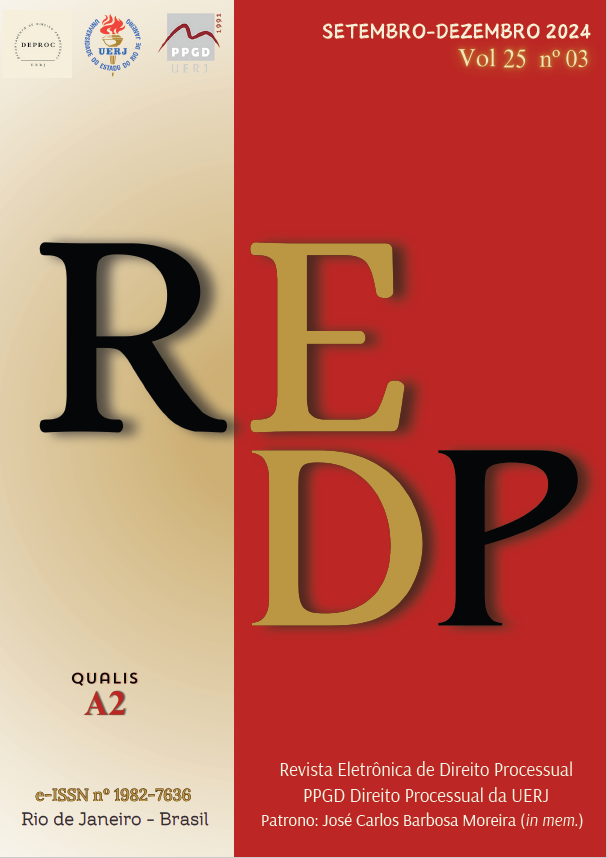MEDIATION IN THE REPUBLIC OF NORTH MACEDONIA: MAIN FEATURES AND TRENDS
DOI:
https://doi.org/10.12957/redp.2024.86602Resumo
O direito de acesso à justiça na República da Macedónia do Norte tradicionalmente implica o direito de acesso ao tribunal e ao juiz. A mediação, como método alternativo de resolução de litígios, ainda não é amplamente conhecida pelo público em geral e pelos profissionais do direito. A principal razão para a introdução da mediação no sistema jurídico da Macedónia foi a necessidade de lidar com atrasos e processos pendentes nos tribunais. Este artigo analisa a situação atual da mediação na República da Macedónia do Norte, destacando algumas das características e tendências mais importantes relacionadas ao procedimento de mediação e aos mediadores, para responder à pergunta: essas características trouxeram ou trarão uma qualidade adicional ao sistema de mediação? O artigo oferece uma visão comparativa das disposições legais sobre o procedimento de mediação e os mediadores. O sistema de mediação na República da Macedónia do Norte foi introduzido em 2006 com a Lei sobre Mediação. Em 2013, uma nova Lei da Mediação foi adotada, seguida por outra nova lei em 2021. Essa abordagem de constante atualização legislativa levanta a questão: essas mudanças foram necessárias e eficazes? A mediação obrigatória, introduzida em 2015 como uma etapa prévia obrigatória para certos tipos de litígios antes do início do processo civil, é uma das características mais notáveis do sistema de mediação macedônio. Como inovação, foi implementado um sistema de licenciamento de mediadores, mas a introdução do mediador licenciado resultou em uma solução jurídica que contraria a regra lex retro non agit. O Conselho Nacional de Mediação foi criado como órgão responsável pela garantia, monitoramento e avaliação da qualidade dos serviços de mediação, estando estreitamente ligado ao Governo. O acordo de mediação como documento executivo e o estatuto de prescrição e exclusão também são características principais do sistema de mediação na República da Macedónia do Norte. Simultaneamente, o artigo discute as consequências dessas soluções jurídicas, as tendências legislativas e os resultados desejados.
Downloads
Publicado
Como Citar
Edição
Seção
Licença
Copyright (c) 2024 Elizabeta Spiroska, Mirjana Ristovska

Este trabalho está licenciado sob uma licença Creative Commons Attribution 4.0 International License.
Todos os artigos publicados na Revista Eletrônica de Direito Processual (REDP) (Departamento de Direito Processual, Universidade do Estado do Rio de Janeiro, Brasil) são licenciados por meio de uma Licença Creative Commons - Atribuição 4.0 Internacional (CC BY 4.0).
Os autores retêm os direitos autorais de seu artigo e concordam em licenciar seu trabalho com a licença CC BY 4.0, aceitando assim os termos e condições específicos desta licença disponíveis no seguinte website: https://creativecommons.org/licenses/by/4.0/legalcode.
- Os autores concedem à REDP o direito de primeira publicação, de se identificar como publicadora original do trabalho e concedem à revista uma licença de direitos não exclusivos para utilizar o trabalho das seguintes formas: Reproduzir, vender e distribuir cópias eletrônicas ou impressas do manuscrito como um todo, de partes específicas do manuscrito e de suas traduções para qualquer idioma;
- O uso do artigo por terceiros é livre, contanto que a integridade da publicação seja mantida e seus autores originais, periódico de primeira publicação e detalhes de citação sejam identificados.
Dentro dos termos da licença, os autores podem entrar em acordos contratuais adicionais separados para a distribuição não exclusiva da versão publicada do trabalho na revista.
Copyright and Licensing
All articles published in the Procedural Law Electronic Review (REDP) (Department of Procedural Law, State University of Rio de Janeiro, Brazil) are licensed under a Creative Commons License - Attribution 4.0 International (CC BY 4.0).
- Authors retain copyright to their article and agree to license their work under the CC BY 4.0 license, thereby accepting the specific terms and conditions of this license available at the following website: https://creativecommons.org/licenses/by/4.0/ legal code.
- Authors grant REDP the right of first publication, to identify itself as the original publisher of the work, and grant the journal a non-exclusive license to use the work in the following ways: Reproduce, sell and distribute electronic or printed copies of the manuscript as a whole, of specific parts of the manuscript and its translations into any language;
- Use of the article by third parties is free, as long as the integrity of the publication is maintained and its original authors, first publication journal, and citation details are identified.
Within the terms of the license, authors may enter into separate additional contractual agreements for the non-exclusive distribution of the published version of the work in the journal.




